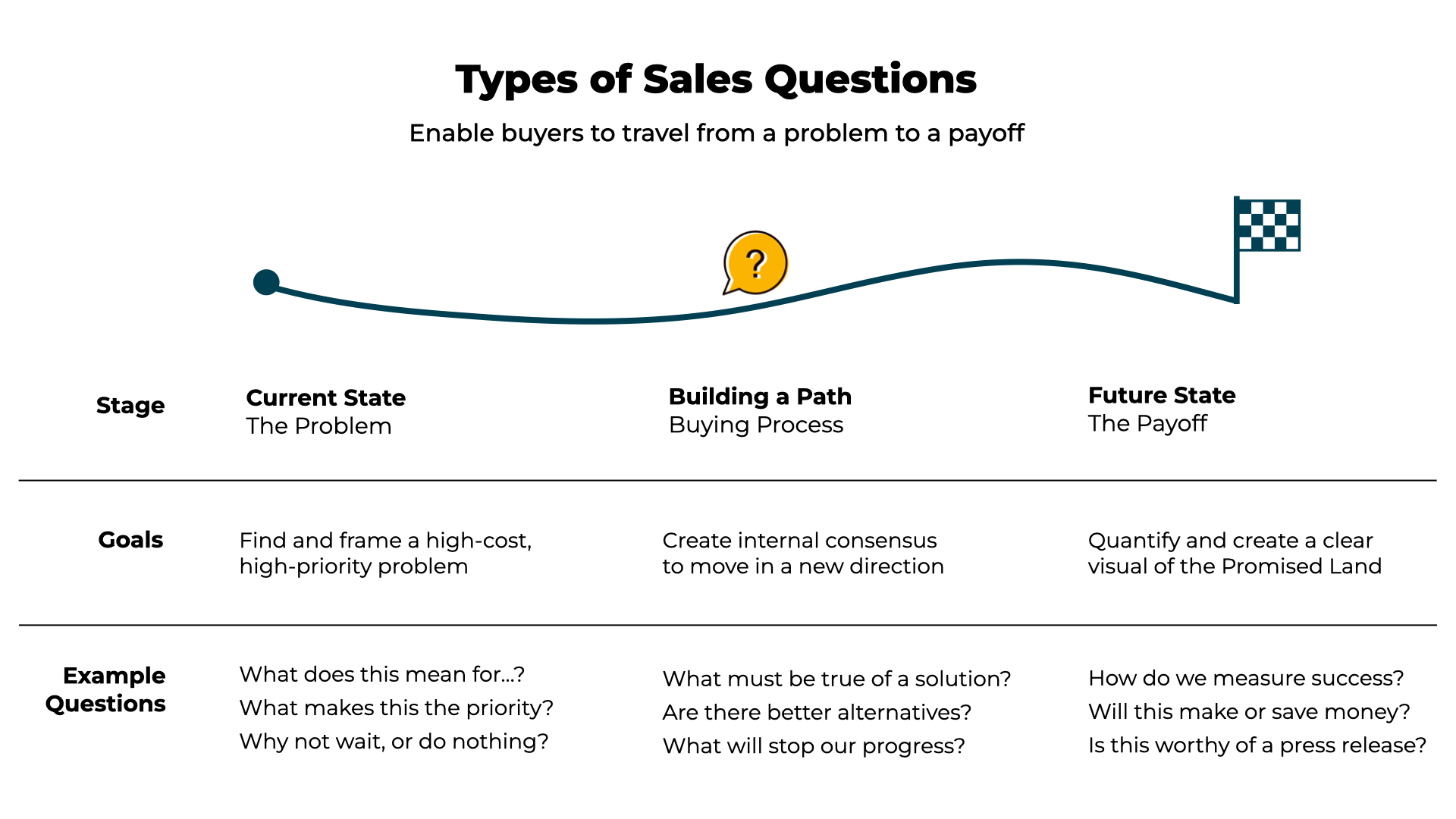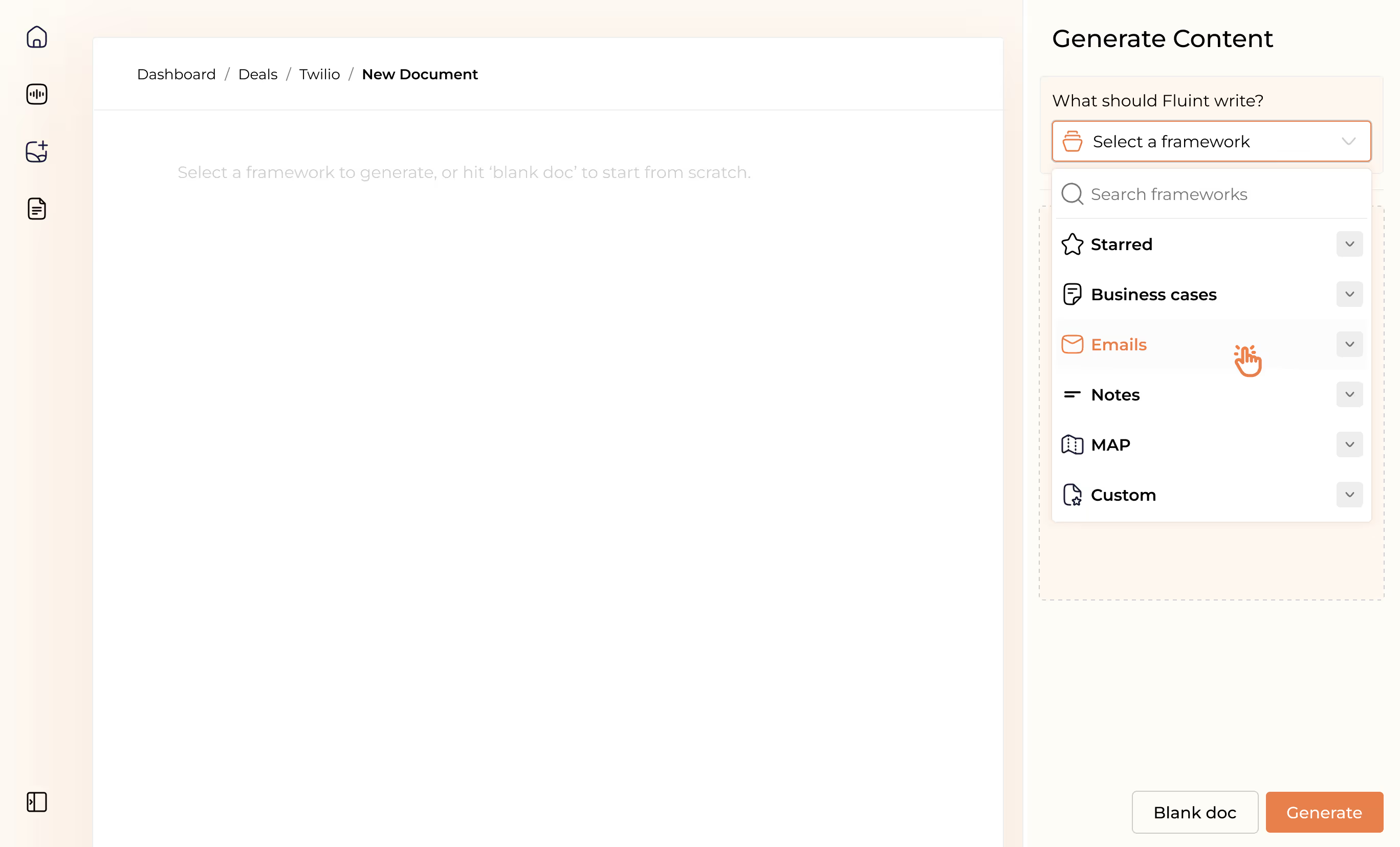How to Ask Better Questions: A Roadmap for More Powerful Discovery


There’s one sales practice that everyone uses, but few master.
It has the ability to:
- Build influence by helping buyers think critically.
- Drop a prospect’s sales resistance to an all-time low.
- Create a process that’s completely focused on buyers.
The practice? Asking good questions.
They Say Curious Sellers are Key. That’s Partially Correct.
From day one, sales reps are taught that genuine curiosity and good questions are the key to selling. It’s true. But it’s not the full story.
We need to go deeper in our thinking about discovery. Asking better questions starts by embracing three truths.
1. Curious reps aren’t enough. We need curious buyers.
Good sales questions are measured by the level of curiosity they spark in your buyer. They move you from simply exchanging information, to examining something your buyers hadn’t considered.
You know you’ve asked a good question when you hear a response that sounds like…
…you know, I’d like to look into this some more.
…huh, I never thought about that before.
…now there’s an interesting question.
These responses let you start selling with your buyers, by creating people who are curious enough to discover the answers alongside you.
2. Good questions are about action. Not information.
Questions are powerful tools in a complex deal with a dozen contacts. As curious buyers go looking for answers, they’ll seek out input from multiple different people.
Think of it this way — meaningful questions require multithreaded responses.
They create new momentum inside your deal, by expanding your reach into every corner of the buying committee.
3. Qualification isn’t discovery. It’s account research.
Sellers often say they “qualify” or “do discovery” as step one in their sales process. These terms aren’t interchangeable, however, because they’re not the same thing. The difference is:
- Qualification is account research. It happens at the start of the cycle, to search for a potential fit with a product based on straightforward questions with known answers.
- Discovery is continuous throughout the sales cycle. It searches for meaningful problems, and uses open-ended questions that require reflection and collaboration.
This difference means discovery is a gift that helps buyers:
- Probe an issue long enough to figure out what’s really going on.
- Speak their true problems out loud, and often for the first time.
- Gain enough conviction in their opinion to push for change.
A Roadmap for Effective Questions During the Buyer’s Journey
Your buyer is on a journey. They’re trying to move from where they are today (a problem), to where they want to be tomorrow (a payoff). Good questions clear a path to help them travel.
This sets up a simple visual, with three types of questions on your discovery roadmap:

I use this visual because it’s easy to remember, and it’s built around the buyer.
Frameworks like MEDDICC, SPIN, BANT, etc. raise some helpful points. But they’re often used as checklists, which results in qualifying, not discovering.
So I prefer to link their points to the three categories in the discovery roadmap. For example, the “M” in MEDDICC is part of the “Payoff.” What metrics matter? How will you impact them?
In the context of enterprise sales, your roadmap should account for the reality that:
- Lots of different contacts need to come along for the ride.
- Each contact’s job sets up a different starting point and view of the problem.
- Contacts will hold conflicting opinions on the right direction to head.
- Varying incentives and personal metrics make for different destinations.
Your job as a seller is to help your champions clarify their path forward, and get every contact on the buying committee moving toward the same goal, at the same time.
With this visual in mind, let’s dig into two topics with the rest of this post:
- Questions you should include in your discovery roadmap.
- Principles for crafting good sales questions.
Top Sales Questions You Should Be Asking
This won’t be an exhaustive list of questions. (I don’t think you need one.) Instead, I’ll focus on a smaller number of high-value questions you’ll want to work into your sales conversations.
1. Problem-Focused Sales Questions
Seeking to Understand:
What's something about this issue that others you’ve shared it with don't always seem to understand?
Buyers love answering this one. It creates the space for someone who’s misunderstood, to share why they feel misunderstood.
That’s cathartic, and it creates the, "Finally, someone who gets me," feeling. After talking through their answer, your words will carry more weight, because you understand in a way others don’t.
Ranking Problems:
I’m guessing < relevant project or problem > isn’t your full-time focus. Which projects would you prioritize over this one in your team’s next meeting agenda?
Most sellers ask questions that tie back to their product. That’s an issue, because it creates the illusion of buying interest. It’s like shining a flashlight in a dark room, while keeping the light beam focused on a small corner. You can't see what else is there.
Better to move the light around the room. It’s how you’ll spot the ghosts.
The phrasing of this question — which assumes **there are higher priorities — helps you learn more about your buyer’s job, and allows them to honestly confirm if another priority is taking up most of their time and attention.
Creating Conviction:
Seems like you’re getting by with < current process > okay. So why not hold off, and come back to this project later on?
Urgency can’t be manufactured in the sales process. It has to be discovered, because the most authentic and effective sources of urgency are internal to the buyer.
This question assumes the buyer’s current status quo is “good enough” for them, so they won’t be willing to make a change without a compelling event, or imminent consequence. Capture their response to this question, and raise it down the line if deal momentum slows.
To go deeper on problem-focused questions, see framing problems, and quantifying them.
2. Process-Focused Sales Questions
Building a Business Case:
Does your team have a standard deck or template for sharing new projects with everyone?
This one is my favorite. Strategic AE Matthew Rogers swears by it. After asking it, work to:
- Get a blank copy of their template
- Match your business case to their internal format
- Co-create the content with your champion
The brilliance here? Matt's point is, “You want someone who wasn’t part of your conversation to digest your message quickly, and be able to articulate it to others. Putting your narrative into a format that’s already familiar makes that easy.”
Requirements Buyers Are Sold On:
What do you believe must be true of a solution for it to work in your case?
Emphasize the words “must be” when using this question. It’s a helpful one because it:
- Surfaces what your buyer’s already sold on
- Helps you influence key requirements
- Lets you challenge their thinking
If you don’t ask this, your buyer will silently wait to confirm if you check the boxes they’re convinced are must-haves. If you hear shallow or informal answers, it’s also a great opportunity to add value by helping them create a decision framework.
Finding the Friction:
Seems like everything’s moving forward smoothly. Is there someone on your team who you think might be willing to disagree with us, so we can be sure we have a fit?
or
It doesn’t seem like < contact name > fully agrees with this point. Is there something you feel we might have missed?
Seek out disagreement, and you'll find the real story of how your deal's developing.
If your sale feels too smooth, there’s a chance your champions are handling all the internal consensus-building alone. They’re sanding down points of friction to keep the deal gliding along.
The reality is someone will have a different opinion. You don’t want to leave champions to find and disarm those opinions alone. Ask questions to gracefully invite yourself into the process.
Creating (Not Allocating) Budget:
I don’t imagine you have extra budget for software just sitting around — it typically has to be created. So if we assume for a minute that you feel it’s worth the effort, how would you go about creating the budget?
Buyers will create a budget where none exists when there’s a meaningful-enough problem, that’s worth solving. This question uses a hypothetical scenario to assume there’s consensus on the problem, so you can dig deeper into their buying process.
Will other budgets need to be shifted around? Will the owners of those budgets go for it? Who would make that call, and who would try to block it?
For more insights on mapping an internal buying process, see this post.
3. Payoff-Focused Sales Questions
Identify Trigger Phrases:
During your last all-hands or executive update, did you hear any certain phrases being repeated? What’s the link between that priority, and our project?
There are always 3 - 5 words that make up ‘Trigger Phrases.’ Executives repeat these phrases over, and over, and over again. It’s their internal shorthand for a priority they’re already sold on.
For example, Jim Franklin (former CEO of Sendgrid) recently shared his phrase with me: ”Make the Mail Move.” Whether you were working on user acquisition, deliverability, or a new product feature, it all tied back to email volume. More accounts, successfully sending more emails.
Understanding Trigger Phrases helps clarify your customer’s desired outcome, and allows you to position your offering as the bridge to get to it.
The Thing Behind The Thing:
Being able to < main product benefit here > is obviously helpful. But beyond the obvious, what does a successful project like this enable you to do, that you can’t today?
Move past surface-level product benefits to the second- and third-order consequences of your solution. This is how your message will create interest at an executive level, and across the whole company. For example:
- More leads generated —> decreased cost to acquire customers —> higher company value.
- Faster support responses —> increased NPS scores —> more revenue retained.
- Better sales materials —> higher close rates —> greater commissions.
Personal Incentives:
Everyone tracks their work a bit differently. For example, I use OKR’s. Are you personally working toward any certain metrics this year?
Identifying how someone is evaluated, compensated, and promoted helps you predict how they’re likely to behave in the buying process. This phrasing helps you approach the topic — which can easily feel salesy, as if you’re asking, “How do I sell you?” — in a more personal way.
Once you’ve identified a buyer’s personal metrics, look at how they tie into their company’s overall goals, and how you’ll influence each metric.
Principles for Asking Better Sales Questions
1. Encourage stories, not statements.
Questions that start with the phrase, “Tell me about when…” encourage buyers to share stories.
Stories elicit emotion, offer context, and lead to deeper understanding than questions that prompt short statements, and yes/no answers.
2. Ask a higher volume of follow-up questions.
As the number of your follow-up questions increases, so does your conversation quality. It’s a signal that you’re listening, and looking to understand. Your follow-up’s will sound something like:
So how does this relate to…?
What does this mean for…?
What’s the connection to…?
3. Share why you’re asking a question.
When someone understands the motives behind your questions, they’re more likely to trust that your intentions are pure, and they’ll be honest with you. The truth is ultimately what you’re after, so start your questions by framing them with phrases like:
The reason I’m asking is…
Typically, I find that… so I’m curious…
Since you mentioned this earlier… it seems like…
4. Create a logical bridge between your questions.
If there’s no logical link between your questions, your buyers will miss out on the power of the Socratic process. It’s the process of helping buyers form their own conclusions — which always leads to a greater level of resolve during the rest of the buying process.
You can also link their prior answers to your future questions by saying:
When you shared… was that related to this?
Aha, so does this connect back to when you said….?
This sounds like when you…
You may even find a connection between different thoughts that your buyers had missed.
5. Adjust the angle of your questions.
Jessie Lewis wrote me on LinkedIn, “I've been trying to ask open-ended questions that are more like 100 degrees open, not 30 degrees!” It’s the perfect metaphor.
Asking closed, highly-angled questions narrows your buyer’s options when responding. This introduces bias, and feels manipulative. On the flip side, broad questions don’t move your conversation forward in a productive direction. “100-degree questions” strike the right balance.

6. Ask the obvious to avoid assumptions.
There are always questions we should ask, but don’t, because we assume we know the answer.
The value of questions isn’t limited to the information sellers gain, however. There’s value in helping buyers name a problem, label its costs, and further explore old issues in new ways.
So, just ask the question. The answer may surprise you.
7. Pepper your questions, don’t pour them.
No buyer wants to feel interrogated. They want to have a conversation. Pepper your meetings with questions as they flow naturally, in between sharing your point of view and customer stories. Don’t pour them out upfront, in a constant flood.
Finally, remember to keep the discovery roadmap from earlier in your mind.
Connect the questions you’re crafting on the fly, back to your three goals:
- Understand where your buyer is today (a problem)
- Clarify the outcome that matters most to them (a payoff)
- Build a bridge between these two states (buying process)
FAQ's on:
Why stop now?
You’re on a roll. Keep reading related write-up’s:
Draft with one click, go from DIY, to done-with-you AI
Get an executive-ready business case in seconds, built with your buyer's words and our AI.

Meet the sellers simplifying complex deals
Loved by top performers from 500+ companies with over $250M in closed-won revenue, across 19,900 deals managed with Fluint

Now getting more call transcripts into the tool so I can do more of that 1-click goodness.



The buying team literally skipped entire steps in the decision process after seeing our champion lay out the value for them.


Which is what Fluint lets me do: enable my champions, by making it easy for them to sell what matters to them and impacts their role.








